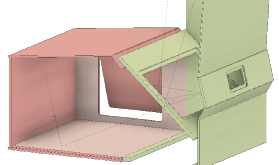
Color appearance of transparent objects is not adequately described by colorimetry or color appearance models. Despite the fact that the retinal projection of a transparent object is a combination of its color and the background, measurements of this physical combination fail to predict the saliency with which we perceive the object's color. When the perceive color forms in the mind, awareness of their physical relationship separates the physical combination into two unique perceptions. This is known as color scissioning. In this paper a psychophysical experiment utilizing a seethrough augmented reality display to compare virtual transparent color samples to real color samples is described and confirms the scissioning effect for lightness and chroma attributes. A previous model of color scissioning for AR viewing conditions is tested against this new data and does not satisfactorily predict the observers' perceptions. However, the model is still found to be a useful tool for analyzing the color scissioning and provides valuable insight on future research directions.